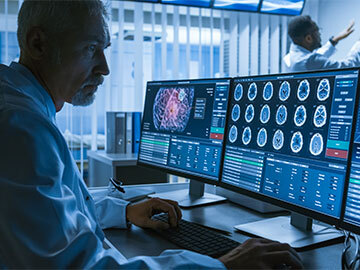Radiologic Technologist projected job growth through 2032: 5.5%

Since the 1990s, a steady rise in the use of diagnostic medical imaging has kept radiologic technologists in high demand. It’s a field that includes numerous sub-specialties, including nuclear medicine technology.
The Key Differences
Here’s a quick breakdown of what the radiologic technologist profession is all about and where it overlaps and differs from nuclear medicine technology:
Job Duties
Radiologic Technologist
Nuclear Medicine Technologist
Education
Radiologic Technologist
Radiologic technologists typically get their start with an associate’s degree; other options include certificate and bachelor’s degree programs.
Nuclear Medicine Technologist
Same as for radiologic technologist.
Certification/Licensing
Radiologic Technologist
Must be licensed or certified in most states; requirements vary but often include graduating from an accredited program and passing a certification exam.
Nuclear Medicine Technologist
Same as for radiologic technologist.
Job Growth Through 2032
Nuclear Medicine Technologist projected job growth through 2032: 0.4%
Source: U.S. Bureau of Labor Statistics Occupational Outlook Handbook, 2023
Next Step?
Radiologic Technologist
Radiologic technologists can get specialty certifications in areas such as radiography (X-ray), computed tomography, magnetic resonance, mammography, and bone densitometry.
Nuclear Medicine Technologist
Specialty certifications are available in positron emission tomography (PET), nuclear cardiology (NCT), magnetic resonance imaging (MRI), or computed tomography (CT).
A couple things to keep in mind about career advancement:
And some notes about the job market: The Bureau of Labor Statistics projects the faster than average job growth for radiologic technologists and MRI techs through 2032 because an older population will need more imaging to treat medical conditions like bone fractures caused by osteoporosis.
Workplace surveys by the American Society of Radiologic Technologists, however, have shown a tightening of the job market for the past several years. Factors have included the uncertainties about health care reform and declining exam reimbursement rates from insurance companies.
Sources: U.S. Bureau of Labor Statistics; Radiologic Sciences Workplace Survey; American Society of Radiologic Technologists.
You may also enjoy:


